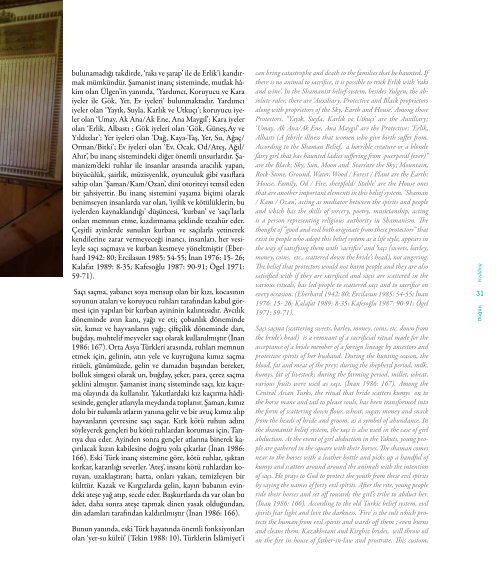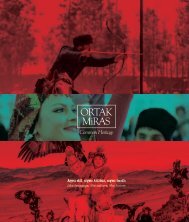You also want an ePaper? Increase the reach of your titles
YUMPU automatically turns print PDFs into web optimized ePapers that Google loves.
ulunamadığı takdirde, ‘rakı ve şarap’ ile de Erlik’i kandırmak<br />
mümkündür. Şamanist inanç sisteminde, mutlak hâkim<br />
olan Ülgen’in yanında, ‘Yardımcı, Koruyucu ve Kara<br />
iyeler ile Gök, Yer, Ev iyeleri’ bulunmaktadır. Yardımcı<br />
iyeler olan ‘Yayık, Suyla, Karlık ve Utkuçı’; koruyucu iyeler<br />
olan ‘Umay, Ak Ana/Ak Ene, Ana Maygıl’; Kara iyeler<br />
olan ‘Erlik, Albastı ; Gök iyeleri olan ‘Gök, Güneş,Ay ve<br />
Yıldızlar’; Yer iyeleri olan ‘Dağ, Kaya-Taş, Yer, Su, Ağaç/<br />
Orman/Bitki’; Ev iyeleri olan ‘Ev, Ocak, Od/Ateş, Ağıl/<br />
Ahır’, bu inanç sistemindeki diğer önemli unsurlardır. Şamanizm’deki<br />
ruhlar ile insanlar arasında aracılık yapan,<br />
büyücülük, şairlik, müzisyenlik, oyunculuk gibi vasıflara<br />
sahip olan ‘Şaman/Kam/Ozan’, dinî otoriteyi temsil eden<br />
bir şahsiyettir. Bu inanç sistemini yaşama biçimi olarak<br />
benimseyen insanlarda var olan, ‘iyilik ve kötülüklerin, bu<br />
iyelerden kaynaklandığı’ düşüncesi, ‘kurban’ ve ‘saçı’larla<br />
onları memnun etme, kızdırmama şeklinde tezahür eder.<br />
Çeşitli ayinlerde sunulan kurban ve saçılarla yetinerek<br />
kendilerine zarar vermeyeceği inancı, insanları, her vesileyle<br />
saçı saçmaya ve kurban kesmeye yöneltmiştir (Eberhard<br />
1942: 80; Ercilasun 1985: 54-55; İnan 1976: 15- 26;<br />
Kalafat 1989: 8-35; Kafesoğlu 1987: 90-91; Ögel 1971:<br />
59-71).<br />
Saçı saçma, yabancı soya mensup olan bir kızı, kocasının<br />
soyunun ataları ve koruyucu ruhları tarafından kabul görmesi<br />
için yapılan bir kurban ayininin kalıntısıdır. Avcılık<br />
döneminde avın kanı, yağı ve eti; çobanlık döneminde<br />
süt, kımız ve hayvanların yağı; çiftçilik döneminde darı,<br />
buğday, muhtelif meyveler saçı olarak kullanılmıştır (İnan<br />
1986: 167). Orta Asya Türkleri arasında, ruhları memnun<br />
etmek için, gelinin, atın yele ve kuyruğuna kımız saçma<br />
ritüeli, günümüzde, gelin ve damadın başından bereket,<br />
bolluk simgesi olarak un, buğday, şeker, para, çerez saçma<br />
şeklini almıştır. Şamanist inanç sisteminde saçı, kız kaçırma<br />
olayında da kullanılır. Yakutlardaki kız kaçırma hâdisesinde,<br />
gençler atlarıyla meydanda toplanır. Şaman, kımız<br />
dolu bir tulumla atların yanına gelir ve bir avuç kımız alıp<br />
hayvanların çevresine saçı saçar. Kırk kötü ruhun adını<br />
söyleyerek gençleri bu kötü ruhlardan koruması için, Tanrıya<br />
dua eder. Ayinden sonra gençler atlarına binerek kaçırılacak<br />
kızın kabilesine doğru yola çıkarlar (İnan 1986:<br />
166). Eski Türk inanç sistemine göre, kötü ruhlar, ışıktan<br />
korkar, karanlığı severler. ‘Ateş’, insanı kötü ruhlardan koruyan,<br />
uzaklaştıran; hatta, onları yakan, temizleyen bir<br />
külttür. Kazak ve Kırgızlarda gelin, kayın babanın evindeki<br />
ateşe yağ atıp, secde eder. Başkurtlarda da var olan bu<br />
âdet, daha sonra ateşe tapmak dinen yasak olduğundan,<br />
din adamları tarafından kaldırılmıştır (İnan 1986: 166).<br />
Bunun yanında, eski Türk hayatında önemli fonksiyonları<br />
olan ‘yer-su kültü’ (Tekin 1988: 10), Türklerin İslâmiyet’i<br />
can bring catastrophe and death to the families that he haunted. If<br />
there is no animal to sacrifice, it is possible to trick Erlik with ‘raki<br />
and wine’. In the Shamanist belief system, besides Yulgen, the absolute<br />
ruler, there are ‘Auxiliary, Protective and Black proprietors<br />
along with proprietors of the Sky, Earth and House’. Among those<br />
Protectors, “Yayık, Suyla, Karlık ve Utkuçı’ are the Auxiliary;<br />
‘Umay, Ak Ana/Ak Ene, Ana Maygıl’ are the Protective; ‘Erlik,<br />
Albastı (A febrile illness that women who give birth suffer from.<br />
According to the Shaman Belief, a horrible creature or a blonde<br />
fairy girl that has haunted ladies suffering from puerperal fever)”<br />
are the Black; Sky, Sun, Moon and Stars’are the Sky; Mountain,<br />
Rock-Stone, Ground, Water, Wood / Forest / Plant are the Earth;<br />
‘House, Family, Od / Fire, sheepfold/ Stable’ are the House ones<br />
that are another important elements in this belief system. ‘Shaman<br />
/ Kam / Ozan’, acting as mediator between the spirits and people<br />
and which has the skills of sorcery, poetry, musicianship, acting<br />
is a person representing religious authority in Shamanism. The<br />
thought of “good and evil both originate from these protectors” that<br />
exist in people who adopt this belief system as a life style, appears in<br />
the way of satisfying them with ‘sacrifice’ and ‘saçı (sweets, barley,<br />
money, coins, etc., scattered down the bride’s head), not angering.<br />
The belief that protectors would not harm people and they are also<br />
satisified with if they are sacrificed and saçıs are scattered in the<br />
various rituals, has led people to scattered saçı and to sacrifice on<br />
every occasion. (Eberhard 1942: 80; Ercilasun 1985: 54-55; İnan<br />
1976: 15- 26; Kalafat 1989: 8-35; Kafesoğlu 1987: 90-91; Ögel<br />
1971: 59-71).<br />
Saçı saçma (scattering sweets, barley, money, coins, etc. down from<br />
the bride’s head) is a remnant of a sacrificial ritual made for the<br />
acceptance of a bride member of a foreign lineage by ancestors and<br />
protective spirits of her husband. During the hunting season, the<br />
blood, fat and meat of the prey; during the shepherd period, milk,<br />
kumys, fat of livestock; during the farming period, millet, wheat,<br />
various fruits were used as saçı. (İnan 1986: 167). Among the<br />
Central Asian Turks, the ritual that bride scatters kumys on to<br />
the horse mane and tail to please souls, has been transformed into<br />
the form of scattering down flour, wheat, sugar, money and snack<br />
from the heads of bride and groom, as a symbol of abundance. In<br />
the shamanist belief system, the saçı is also used in the case of girl<br />
abduction. At the event of girl abduction in the Yakuts, young people<br />
are gathered in the square with their horses. The shaman comes<br />
near to the horses with a leather bottle and picks up a handful of<br />
kumys and scatters around around the animals with the intention<br />
of saçı. He prays to God to protect the youth from these evil spirits<br />
by saying the names of forty evil spirits. After the rite, young people<br />
ride their horses and set off towards the girl’s tribe to abduct her.<br />
(İnan 1986: 166). According to the old Turkic belief system, evil<br />
spirits fear light and love the darkness. ‘Fire’ is the cult which protects<br />
the human from evil spirits and wards off them ; even burns<br />
and cleans them. Kazakhstani and Kirghiz brides, will throw oil<br />
on the fire in house of father-in-law and prostrate. This custom,<br />
Wedding<br />
31<br />
Düğün
















